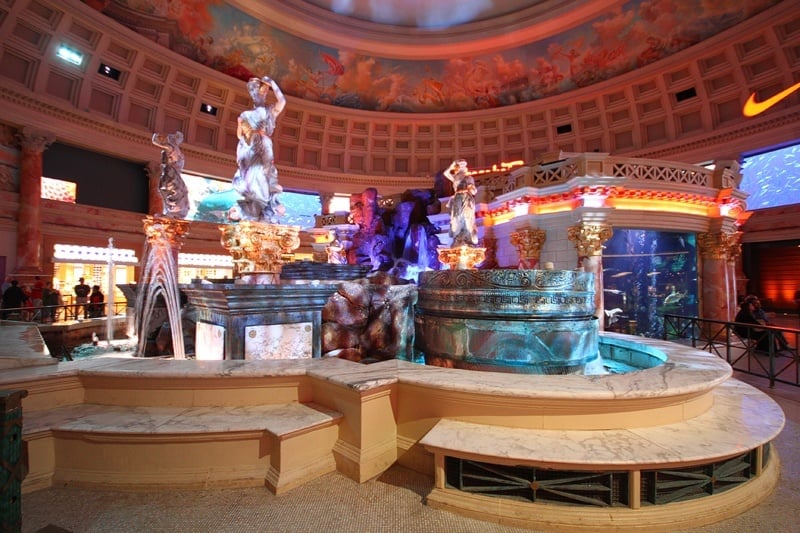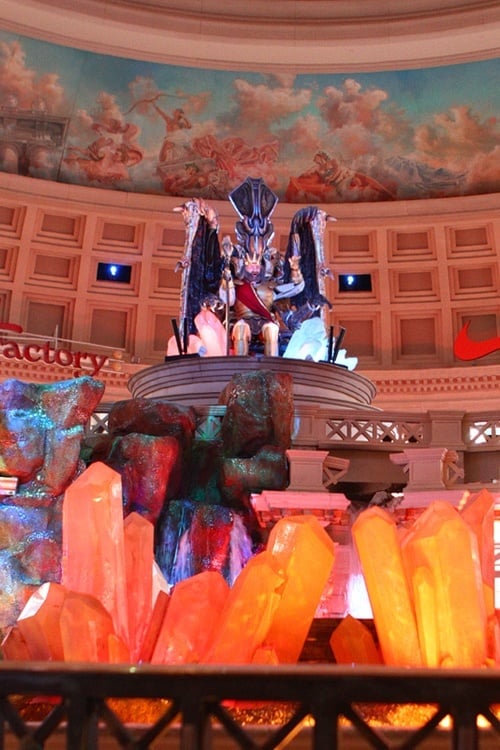Reskinned “Fall of Atlantis” Attraction Chronicles Rise and Fall of Nazi Germany at The Forum Shops
The iconic “Fall of Atlantis” attraction at The Forum Shops inside Caesars Palace recently got a much-needed renovation.
Thousands of Las Vegas visitors flock to see this wonder of animatronics and pyrotechnics each year, but what they may not realize is they’re getting an important history lesson along with their free entertainment.

On its surface, the “Fall of Atlantis” show tells a story of sibling rivalty which ultimately results in the sinking of the mythical city of Atlantis. But beneath the insipid dialogue, and animatronics considered cutting-edge in 1964, there’s a powerful metaphor for the geopolitical conflicts leading to World War II and the near destruction of Europe.
“Fall of Atlantis” opens with King Atlas debating who should assume the throne of Atlantis. His daughter, Alia, wields the power of water and his son, Gadrius, controls fire.

Ultimately, the gods become displeased with Atlas and his bickering offspring and cause the seas to rise, thus engulfing the city.
Examining the story and characters further, however, it’s obvious there’s more to “Fall of Atlantis” than meets the eye.
You see, in mythology, Atlas is king and overlord of the 10 kingdoms of Atlantis. Before the 1800s, Germany was a loosely-connected group of small “kingdoms.”
Beyond that, the struggle between the siblings for power in “Fall of Atlantis” can be compared directly to the political climate in Germany in 1932. Prior to the rise of the Nazi party, there were two main political parties vying for control of Germany, the Communist Party and Social Democratic Party. In “Fall of Atlantis,” Alia and Gadrius represent these embattled political movements.

Early in “Fall of Atlantis,” Atlas draws attention to an outcropping of “magic crystals” (pictured below), the source of Atlantis’ power. This is an obvious reference to the emperiled German economy which, because of the Great Depression, saw unemployment rise from 8.5% to 30% between 1929 and 1932.

“Fall of Atlantis” is a dramatic representation of the evil which can result from political and economic turmoil, as evidenced by the “gods” destroying Atlantis, just as Europe was ravaged by war.
Despite Atlas imploring his children to reconcile, they ignore his advice, much as the 1919 Treaty of Versailles was ignored by the Germans after World War I.

As Atlantis faces its destruction in “Fall of Atlantis,” a winged beast rises ominously behind Atlas’ throne. This creature is analogous, of course, to the black eagle used as an emblem of the National Socialist German Workers Party, or Nazi party.
It’s telling that the winged creature in “Fall of Atlantis” looks both to its right and left during the show’s finale. This is the main distinguishing feature between a traditional German eagle (the Reichsadler, looking over its right shoulder) and the emblem used by the Nazi party (the Parteiadler, looking over its left shoulder).

Eventually, the gods rain down lightning (symbolic of the insignia of the Schutzstaffel, or SS) upon Atlantis, and cause the seas to rise, analogous to the militarism that engulfed Europe, and the world, until World War II ended in 1945.
It’s worth noting, of course, that after World War II ended, Germany was split into two blocs, East and West. Again, the analogy of rival siblings in “Fall of Atlantis” has layers of complexity beneath it.
Of course, not everyone agrees with our theories about “Fall of Atlantis,” but maybe they’re not looking closely enough.

Judge for yourself. Here’s the new “Fall of Atlantis” show, in its entirety.
One need not be aware of the historical allegory being told in “Fall of Atlantis” to appreciate it. There are dancing fountains, pillars of fire and nine-foot-tall animatronics to capture the imagination.
The free “Fall of Atlantis” show plays at the top of each hour, beginning at 11:00 a.m. each day.





Leave your thoughts on “Reskinned “Fall of Atlantis” Attraction Chronicles Rise and Fall of Nazi Germany at The Forum Shops”